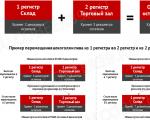Causes of design basis accidents. Accidents at radiation hazardous facilities. Beyond design basis accident – an accident caused by initiating events not taken into account for design basis accidents or accompanied by additional failures of safety systems compared to design basis accidents
Notifying the population of the city of Moscow about emergency situations (ES) is the delivery of warning signals and emergency information about the dangers that arise when there is a threat or occurrence of a natural or man-made emergency, about the rules of behavior of the population and the need to take protective measures.
Public address system - component control system for civil defense and RSChS, which is an organizational and technical unification of forces and special technical means alerts, broadcast networks, public communication network channels and departmental communication networks
In accordance with the Decree of the Moscow Government dated December 1, 2015 No. 795-PP, public emergency warning systems in Moscow operate at the following levels:
I. Regional (regional emergency warning system for Moscow)
II. Municipal (local emergency warning systems for urban districts and settlements)
III. Object (local warning systems (LSS) at potentially dangerous objects and object warning systems (OSS) in organizations).
Emergency warning systems in Moscow at the regional, municipal and site levels interact organizationally, technically and programmatically.
In accordance with Federal Law No. 28 dated January 28, 1998 (Article 7.9), Order of the Ministry of Emergency Situations of the Russian Federation, Ministry of Information and Communications of the Russian Federation, Ministry of Culture of the Russian Federation dated July 25, 2006 No. 422/90/376, Decree of the Moscow Government dated December 1, 2015. No. 795-PP (clause 1.3) are required to have an OSO associated with a centralized warning system:
Socially important objects, life support objects:
- cultural objects (museums, exhibitions, etc.);
- educational institutions;
- medical institutions;
- sports facilities;
- hotels, hostels, guest houses;
- hypermarkets, markets, shopping centers;
- entertainment centers, establishments;
- business centers of classes A, B and C;
- financial institutions(banks and their branches, insurance companies, loan centers, etc.).
Objects for various purposes with simultaneous presence of more than 50 people.
In accordance with Government Decree Russian Federation No. 447 Part 3 P. 18 all hotels regardless of category must be equipped with emergency warning systems about the threat or occurrence of emergency situations and are interfaced with the regional emergency warning system of Moscow
In accordance with the Decree of the Moscow Government dated December 1, 2015 No. 795-PP, property owners are obliged to:
- Create and maintain in constant readiness on-site emergency warning systems, ensure their interface with the regional warning system of Moscow.
- The constant readiness of public emergency warning systems is achieved by timely and high-quality operational and technical maintenance of warning means;
- Maintain the main and backup communication channels to control the warning system in constant readiness;
- Promptly and reliably notify employees and visitors of organizations about the threat or occurrence of an emergency, inform about techniques and methods of protection against them;
MGTS provides connection (interconnection) services to owners of facilities object systems notification (OSO) with a centralized (municipal and regional) warning system in Moscow.
Composition of the service provided by MGTS:
1. Information support on the pairing procedure
2. Technical inspection of the facility and development of a technical solution
3. Organization of a communication channel, installation and configuration of equipment for interfacing.
Design-basis accident
an accident, the possibility of which is provided for by the current regulatory and technical documentation of a given nuclear installation and for which technical project provision is made to ensure radiation safety of personnel and the population.
-
Civil protection. Conceptual and terminological dictionary
- - an industrial accident for which the design defines the initial and final states and provides safety systems to ensure that the consequences of the accident are limited to established limits...
- - Design basis accident with the most severe consequences. Source: GOST R 12.3...
Glossary of emergency terms
- - An accident for which the provision of a given level of safety is guaranteed by those provided for in the design industrial enterprise security systems. Source: GOST R 12.3...
Glossary of emergency terms
-
Glossary of emergency terms
- - see Industrial design accident...
Glossary of emergency terms
- - see Design-based radiation accident...
Glossary of emergency terms
- - an accident for which the design defines the initial and final states of the radiation situation and provides safety systems...
Nuclear energy terms
- - Design-basis accident is an accident, the possibility of which is provided for by the current regulatory and technical documentation of a given nuclear installation and for which the technical design provides for the provision of radiation...
Nuclear energy terms
- - 1. temporary organizational structure, formed to achieve a specific, clearly defined goal 2. a permanent organization developing construction, organizational, technical and technological projects...
- - see PROJECT source: Terminological dictionary for construction for 12...
Construction dictionary
- - a line depicting the position of the edge of the roadbed on the longitudinal profile...
Construction dictionary
- - the capacity provided for by the design of a given production, workshop, unit, installation...
Dictionary of business terms
- - production capacity provided for by the approved design of the commissioned enterprise, workshop, unit, installation. During the development of P.m. determined taking into account the standard deadlines for its development...
Large economic dictionary
- - "...1. - an accident for which the design defines the initial and final states of the radiation situation and provides safety systems..." Source: "SP 2.6.1.799-99. OSPORB-99. 2.6.1...
Official terminology
"Design-design accident" in books
Project Democracy
From the author's bookProject democracy The experience of the USSR shows that democracy has room to develop in its technical application. However, in the revolution of 1985–1999, we refused to develop public power and institutionalize the management of society. We took a step back, unable to resist
5.3. Project team
From the book Investment projects: from modeling to implementation author Volkov Alexey Sergeevich5.3. Project team The project team can consist of people involved on a temporary or permanent basis. Many project team members may combine this activity with some other activity. The project group is the core of the project; it includes all the key elements for the project.
31. PROJECT STRUCTURE OF THE ORGANIZATION
From the book Organization Theory: Cheat Sheet author Author unknown31. PROJECT STRUCTURE OF AN ORGANIZATION Project structure is used in cases where a decision is made to concentrate the maximum amount of the organization's resources on a specific project within a specific period. Any process is considered a project
Project team
From the book HR in the fight for competitive advantage by Brockbank WayneProject team Create project team, which includes key stakeholders - line managers, HR employees from corporate services and departments, specialists, and if necessary external consultants. Give the group a task: create a model
Research project activities
author Veraksa Nikolay EvgenievichResearch project activity The originality of research project activities is determined by its purpose: the study involves obtaining an answer to the question of why this or that phenomenon exists and how it is explained from the point of view of modern
Creative project activity
From the book Project activities for preschoolers. Manual for teachers preschool institutions author Veraksa Nikolay EvgenievichCreative project activity In the course of creative project activity, a new creative product is created. If research project activities, as a rule, are individual in nature, then creative project often carried out collectively or
Regulatory project activities
From the book Project activities for preschoolers. A manual for preschool teachers author Veraksa Nikolay EvgenievichNormative project activities Projects to create norms are an extremely important area in pedagogical activity, since they develop the positive socialization of children. These projects are always initiated by the teacher, who must clearly understand
RUSSIAN DESIGN ALTERNATIVENESS – YESTERDAY, TODAY, TOMORROW
From the book Ark // No. 1 [Almanac of the “Alternative Models of Development” (ALMOR) direction of the “Essence of Time” movement] author Kurginyan Sergey ErvandovichRUSSIAN DESIGN ALTERNATIVENESS – YESTERDAY, TODAY,
Project activities
From the book Modern technologies teaching history at school author Studenikin Mikhail TimofeevichProject activities Nowadays, it is important to turn to project activities, when high school students create and defend their projects, just like university students do their coursework and theses. A project is a prototype, a prototype of any type of activity, object,
Project documentation
From the book How to Test at Google author Whittaker JamesProject documentation Every project at Google has a master project document. This is a living document, it develops along with the project. First, this document describes the purpose of the project, the prerequisites for its creation, the expected list of participants and architectural solutions. On
2.5. PROJECT PROCEDURE FOR SETTING THE PROGRAM DEVELOPMENT TASK
From the book Programming Technologies author Kamaev V A2.5. PROJECT PROCEDURE FOR SETTING THE PROBLEM DEVELOPMENT PROBLEM The project procedure is based on the possession systematic approach in relation to analysis software systems. Initially, a system is considered - a person (people), a computer, a program, other objects, for example
Russian aircraft (project activities)
From the book Geometric mosaic in integrated classes. Lesson notes for children aged 5-9 years author Novikova Valentina PavlovnaRussian aircraft (project activities) Goal. Develop children's horizons, the ability to independently acquire knowledge, work with sources, convincingly substantiate what is planned during the presentation of the project, work independently and in a team. Material. Big set
Design capacity of Pushkin
From the book Literary Newspaper 6305 (No. 4 2011) author Literary NewspaperDesign capacity of Pushkin Literature Design capacity of Pushkin STUDIES Marina KUDIMOVA Man, whether he is the king of nature or not, is distinguished from other biological species by many things. Too much. Including the desire for project activities. Design is inherent in
Land lease and project documentation
From the book Your Own Business. Everything aspiring entrepreneurs need to know author Malitikov Pavel NikolaevichLand lease and design documentation After you select a site for a parking lot, you should obtain the right to rent it. This is a rather difficult issue, the solution of which will require a number of approvals, documents and considerable cash. If
55. Project documentation
From the book Instrumentation author Babaev M A55. Design documentation Design documentation, which is the result of the design of the ACS and control, as a rule, consists of two parts.1. At the “design task” stage, issues related to the object itself are studied; basic characteristics questions
Under design basis accident is understood as an accident for which the initial events of emergency processes characteristic of a particular facility are defined in the project.
Maximum design basis accidents are characterized by the most severe initiating events that cause the occurrence of an emergency process at a given facility.
Under beyond design basis (hypothetical) accident refers to an accident that is caused by initiating events that are not taken into account for design basis accidents and is accompanied by additional failures of safety systems compared to design basis accidents.
66. Features and advantages of ru brest:
natural radiation safety
long-term provision of fuel resources due to effective use natural uranium;
eliminating the production of weapons-grade plutonium
environmentally friendly energy production and waste disposal
economic competitiveness due to the natural safety of nuclear power plants and fuel cycle technologies, abandonment of complex engineering systems security
67. Environmental consequences of nuclear power plant operation
The main environmental problems of nuclear power plant operation. Compared to fresh fuel, its composition contains less uranium-235 (since it burns out), but it accumulates isotopes of plutonium, other transuranium elements, as well as fragments, or fission products - medium-mass nuclei. Over time, the physical characteristics of the structural materials of fuel assemblies also change.
Dismantling of a nuclear power plant upon completion of its normal operation.
68. Main radionuclides generated during the operation of nuclear power plants and their effects on the body
Tritium − can enter the human body through inhalation, as well as through the skin. In the presence of tritium, the entire human body is exposed to β-radiation with a maximum energy of 18 keV.
Carbon-14− The effect of ionizing radiation on humans is mainly due to the consumption of food (milk, vegetables, meat).
Krypton− The radiological impact of 85 Kr on humans occurs mainly due to irradiation of the skin.
Strontium− 90 Sr enters the human body with food (milk, vegetables, fish, meat, drinking water). Like calcium, 90 Sr is deposited mainly in bone tissues, which contain vital hematopoietic organs.
Cesium− The radiological impact of cesium, like 90 Sr, on humans is associated with its penetration into the human body along with food. In living organisms, cesium can largely replace potassium and, like the latter, spread throughout the body in the form of highly soluble compounds.
69. SNF− irradiated nuclear fuel, spent fuel elements (fuel elements) of nuclear reactors of nuclear power plants removed from the active zone.
RAO− substances in any state of aggregation in which the content of radionuclides exceeds levels not intended for further use.
70. Features of handling spent fuel:
Nuclear hazard (criticality);
Radiation safety;
Residual heat release.
Ensuring subcriticality throughout the entire operation time;
Prevention of physical damage to the fuel assembly and/or fuel rods;
Ensuring reliable heat supply;
Maintaining the level of radiation exposure and release of radioactive substances when handling irradiated fuel at a reasonably achievable level.
72. The list of technological operations for SNF management may include:
Interim storage of spent fuel assemblies in the spent fuel pool;
Transportation of spent fuel to a reprocessing plant, temporary storage facility or repository;
Interim storage before processing or disposal;
Reprocessing or preparation of spent fuel assemblies for temporary storage or disposal;
Temporary storage or burial.
73. Radioactive waste management
The typical sequence of waste management operations is collection, separation, characterization, treatment, conditioning, transportation, storage and disposal.
74. Characteristics of radioactive waste used for their classification+75. RW classification
There are a number of criteria by which radioactive waste is classified.
By activity and heat levels, with the definition of quantitative characteristics:
High level waste; long rao
Intermediate level waste;
Low level waste; briefly rao
Very low level waste.
By half-life of radionuclides, which determines the time of their potential danger:
Very short-lived;
Short-lived;
Medium-living;
Long-lived.
According to the nature of the prevailing radiation:
Design basis accident – an accident for which the design defines the initial events and final states and provides safety systems that, taking into account the principle of a single failure of safety systems or one personnel error independent of the initial event, limit its consequences to the limits established for such accidents.
Beyond design basis accident – an accident caused by initiating events not taken into account for design basis accidents or accompanied by additional failures of safety systems in comparison with design basis accidents in excess of a single failure, or the implementation of erroneous decisions of personnel.
Severe beyond design basis accident – a beyond design basis accident with damage to fuel elements above the maximum design limit, in which the maximum permissible emergency release of radioactive substances into the environment can be achieved.
Rice. 1. Schematic diagram of PHRS PG and PHRS ZO
1 – emergency heat removal tanks; 2 - steam lines; 3 – condensate pipelines; 4 – SG PHRS valves; 5 – heat exchangers-condensers SPOT-ZO; 6 – steam generators; 7 – shut-off valves
1 - reactor; 2 – melt localization device; 3 – fuel pool; 4 – shaft for inspection of internal devices; 5 – pit tanks; 6 – pipeline for supplying water to the surface of the melt; 7 – water supply pipeline to the ULR heat exchanger
α-emitters;
β-emitters;
TEST TASKS FOR PREPARATION FOR GIA IN THE DISCIPLINE “RADIATION HYGIENE”
Choose one correct answer:
1. The main measures to ensure radiation safety include:
1) legal, epidemiological, sanitary and hygienic
2) legal, organizational, sanitary and hygienic
3) economic, organizational, epidemiological
4) operational, organizational, sanitary and hygienic
5) legal, organizational, epidemiological
2. Reducing the radiation exposure of patients during radiography is ensured by:
1) serviceability of the device
2) compliance of the device technical standards
3) correct choice of picture mode
4) filtration of the primary beam
5) all of the above are true
3. Weighting factors for individual species ionizing radiation is used in calculations:
1) exposure dose
2) absorbed dose
3) equivalent dose
4) effective dose
5) radiation output
A copy of the worker’s radiation dose card must be kept in medical organization after his dismissal for ______ years
5. The main contribution to public exposure comes from the following sources:
1) global radioactive fallout
2) accidents at nuclear power plants
3) natural background radiation, technologically modified
natural background radiation, x-ray and radiological
diagnostics in medicine
4) nuclear power plants in conditions regular work
5) everything is true
6. Irradiation of patients during X-ray diagnostics is regulated by:
1) Radiation safety standards (NRB-99/2009)
2) Basic sanitary rules for ensuring radiation safety (OSPORB-2010)
3) SanPiN 2.6.1. 1192-03 “Hygienic requirements for the design and operation of X-ray rooms, devices and the conduct of X-ray examinations”
4) Federal law“On radiation safety of the population”
5) everything is correct
Scheduled radiation monitoring at enterprises,
using sources of ionizing radiation, includes:
1) determination of natural background radiation levels
2) duration assessment technological processes
3) assessment of dose rates at workplaces, determination of the content of radionuclides in the air of the work area, medical control for staff
4) determination of levels of technologically altered natural background radiation
6) everything is correct
8. Radiation monitoring devices are divided into:
1) individual
2) wearable
3) portable
4) stationary
5) everything is correct
Sanitary dosimetric control in medical institutions
includes:
1) measurement of external radiation dose rate
2) individual dosimetric control
3) determination of concentrations of radioactive gases and aerosols in
4) control over the collection, storage and disposal of radioactive waste
5) everything is true
10. The level of radioactive contamination of surfaces is expressed in:
3) Frequency/cm 2 /min
4) microR/hour
11. Weighting factors for tissues and organs are used when calculating:
1) exposure dose
2) absorbed dose
3) equivalent dose
4) effective dose
5) ambient equivalent dose
12. The principle of optimizing radiation safety when conducting x-ray studies assumes:
1) organization of a single radiology department for hospitals and clinics
2) conducting x-ray examinations as directed by the attending physician
3) establishing control levels of exposure for different types procedures and refusal of unjustified studies
4) maintaining radiation doses to patients as low as possible while maintaining the quality of their examination and treatment
5) compliance with radiation safety standards
Solid radioactive waste is treated before disposal
methods:
1) burning
2) vitrification, bituminization, cementation of vitrification,
cementing
3) grinding
4) pressing
5) everything is true
14. The activity of a radioactive substance is:
1) absorbed energy calculated per unit mass
2) the amount of radiation emitted by radioactive atoms
3) the number of radioactive decays of atomic nuclei per unit time
4) time of removal of radionuclides from the body
5) dose created per unit of time
15. Radiation monitoring at personnel workplaces, adjacent rooms and areas adjacent to the X-ray room must be carried out at least once every:
16. Highest concentration radon is noted:
1) in the ground layer of air in winter
2) in the ground layer of air in summer
3) in the air over the ocean
4) in soil air
5) in the upper atmosphere
17. Observation and control of the radiation situation beyond the sanitary protective dose is carried out by:
1) radiation control groups of the enterprise itself
2) organizations licensed to carry out such work
3) territorial offices of Rospotrebnadzor
4) regional bodies of Rostechnadzor
An accident for which the project defines the initial and final events is called:
2) design
3) actual
4) technical
5) hypothetical
19. The biological effect of radiation depends on:
1) dose received
2) body reactivity
3) irradiation time, intervals between irradiations
4) dimensions and localization of the irradiated surface
5) all of the above are true
20. Radioactive waste in medical institutions includes:
1) radioactive aerosols removed from fume hoods and
2) liquid radioactive waste resulting from
equipment decontamination
3) radioactive waste released with the excrement of patients
4) used tools, overalls, personal protective equipment from open source departments






Design basis accident
















